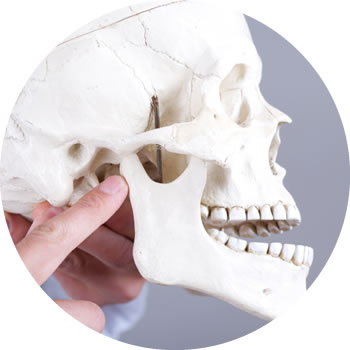Jaw Joint Problems
Painful Jaw Joint
Temporomandibular Joint Dysfunction is an alteration of the structures that compose the temporomandibular joint (TMJ).
The temporomandibular joints are those that connect your lower jaw to the skull and are composed of bone, muscle and joint structures. There are two matching joints, one on each side of the head, located just in front of the ears.
In fact, these joints are among some of the most frequently used joints in the body, put to use when we talk, chew, yawn, swallow and sneeze.
The TMJ disorder occurs when these joints and/or muscles and ligaments that support them are injured, causing dysfunction and pain
The TMJ syndrome is widely regarded as the most common cause of facial pain, after toothache. Studies reflect a higher incidence of the disease in younger adults, especially in women aged 20-40 years of age
Signs and Symptoms
Symptoms of the TMJ syndrome are studied largely in direct context of the joint structures affected. Here we list the main ones along with their specific locations:
- Teeth and Mouth: Bruxism (tightening or grinding of teeth), loose or fragile teeth perception, discomfort while chewing, dry mouth, hot or scalded mouth.
- Mandibular problems: Joint noises or clicking, jaw muscle pain, limitation in the mouth's openness, jaw displacement while opening mouth, dislocations or blocks while opening/closing mouth, swollen muscles.
- Facial pain or Headache: Frontal area headaches, false migraine, nasal obstruction, pain the back/top area of the head.
- Eyes: Pain, photophobia, altered vision.
- Ear: Noises, loss of hearing, earache, itching, vertigo
- Throat: Burning, inflammation, congestion, difficulty in swallowing
- Neck and back: Muscular inflammation, reduced mobility
Causes of TMJ
TMJ is widely regarded as a multifactor syndrome, having a number of contributory factors that might be a cause of the condition. These include:
- Genetic predisposition
- Bruxism (habit of grinding teeth)
- Postural habits
- Trauma to the joint from a blow on the jaw or head
- Anxiety, stress, depression
- Arthritis of TMJ
- Dislocation of the disc
- Whiplash injury
- Thumb sucking
- Jaw abnormalities/missing teeth
- Birth/Congenital trauma
- Psychological factors
Investigation
A thorough clinical examination is undertaken. Often imaging of the joint (MRI scan) can be helpful in identifying problems within the joint.
If there are problems within the joint arthroscopy (telescope examination) may be used for further diagnosis and treatment
Treatment
Physical treatment
Physical treatment for TMJ syndrome normally includes thermo therapy (hot/cold), freezing sprays, physiotherapy (massages/exercises), Transcutanius electrical nerve stimulation (TENS) and ultrasound.
Drug Treatment
Common drugs prescribed for this condition include:
- Painkillers
- Anti-inflammatories
- Anesthetics
- Muscle Relaxers
- Anxiolitics
- Antidepressives
Stress Counselling
In cases where the causative factors are apparently psychic based (anxiety, depression), it is very crucial to adopt this approach.
Oclussal Splint
In cases where Bruxism is a possible cause, mouth moulds are taken and an intraoral appliance, called as oclussal splint is built with acrylic resin.
Surgery
In cases where there are internal problems with the joint (eg. Clicking/locking/pain) Arthroscopy may be used to free up the disc. This is where a small telescope is inserted into the joint
Occasionally in severe cases open surgery may be used.

